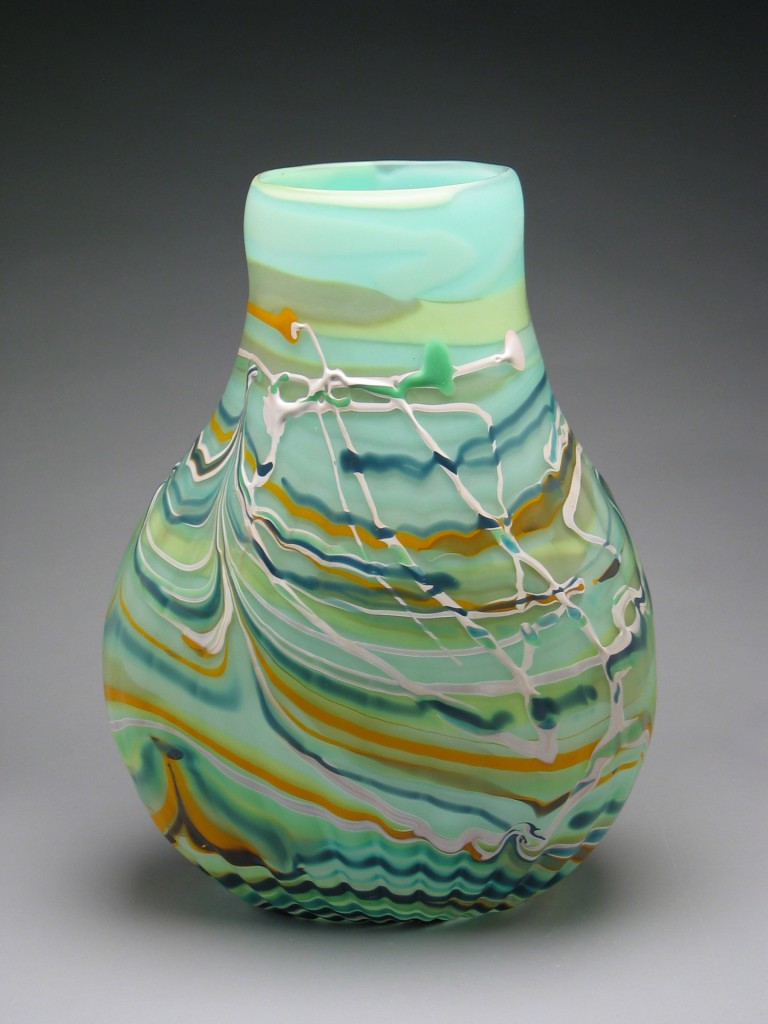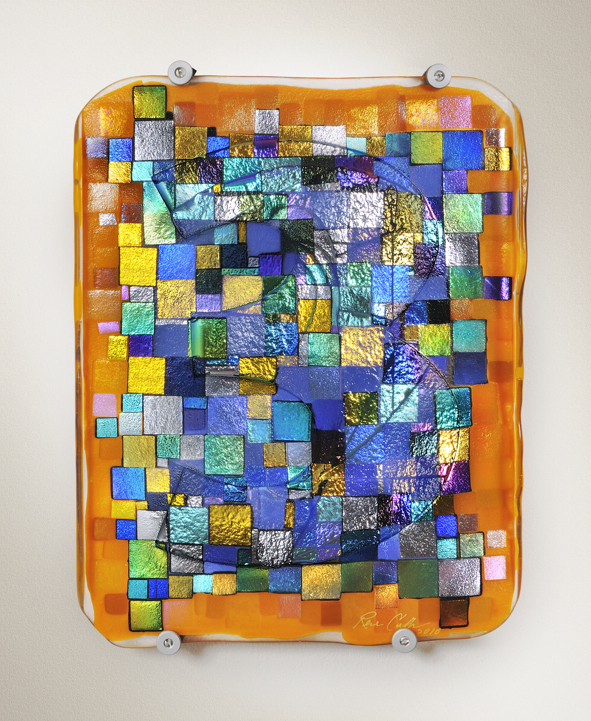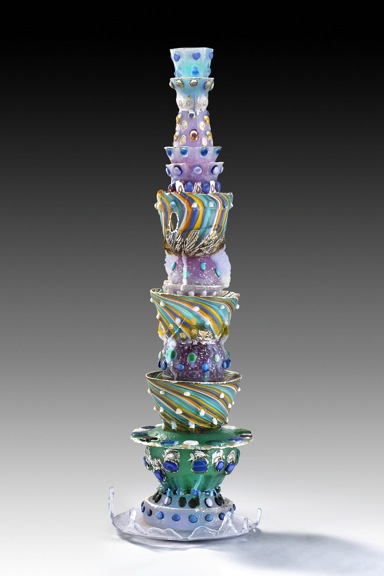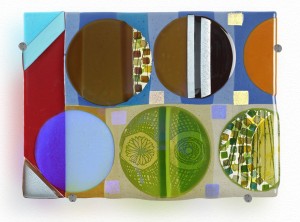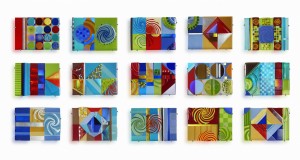Blown Glass
PAINTED POTS
I began this work while researching Korean forms in ceramics, before my fellowship period began. This began with making objects in the flask form. I also began to flatten blown work to produce ovoid shapes. Two sides were selected to display color as two sided paintings.
These objects are very textural, colorful, and reminiscent of the little core vessels that can be seen in Egyptian museum displays. The vessels held kohl, or unguents and were small enough to fit in the palm of one’s hand. My vessels are about 100x larger, and shaped in a variety of formations. I employ the use of colored glass trailings on the surface of the glass. The applied colors are disturbed while hot and still semi-liquid, by blowing into a metal mold, or by the use of a metal hook that festoons or feathers the color into a zig- zag pattern.
Upon return to the U.S., I began to see a connection to the landscape and the figure. In Korea, large mountain boulders are sometimes regarded as figurative, (in one case, two boulders are regarded as “monks.”.) I began to remember landscapes in the west, and also the patterns and color of the beaches of the Gulf.
The use of color and how it is applied is very important, and accomplished by the use of layers of application as in painting. I look to my undergraduate professor for inspiration: Prof. Julian Stanzsak for whose work the term, “Op Art” was coined as a description of the work in his New York exhibition.
The forms are some times derived from amphorae, but recent work is opened in a non-traditional manner with sculptural tools in reference to the “monk boulders.”
Work for the Wall
BYZANTIUM
The Byzantium series is inspired by the richly colored mosaics encountered in Istanbul, Turkey. The passage of time, always a theme, is depicted by numbers in the series. The world is digital; images, music, passwords, and codes represent the individual in one form or another. Each number (in the Helvetica font) from 0 to 9, is stacked; one upon the other and in order. Shapes are created from the stacking, and the surface of the image becomes tactile and topographical.
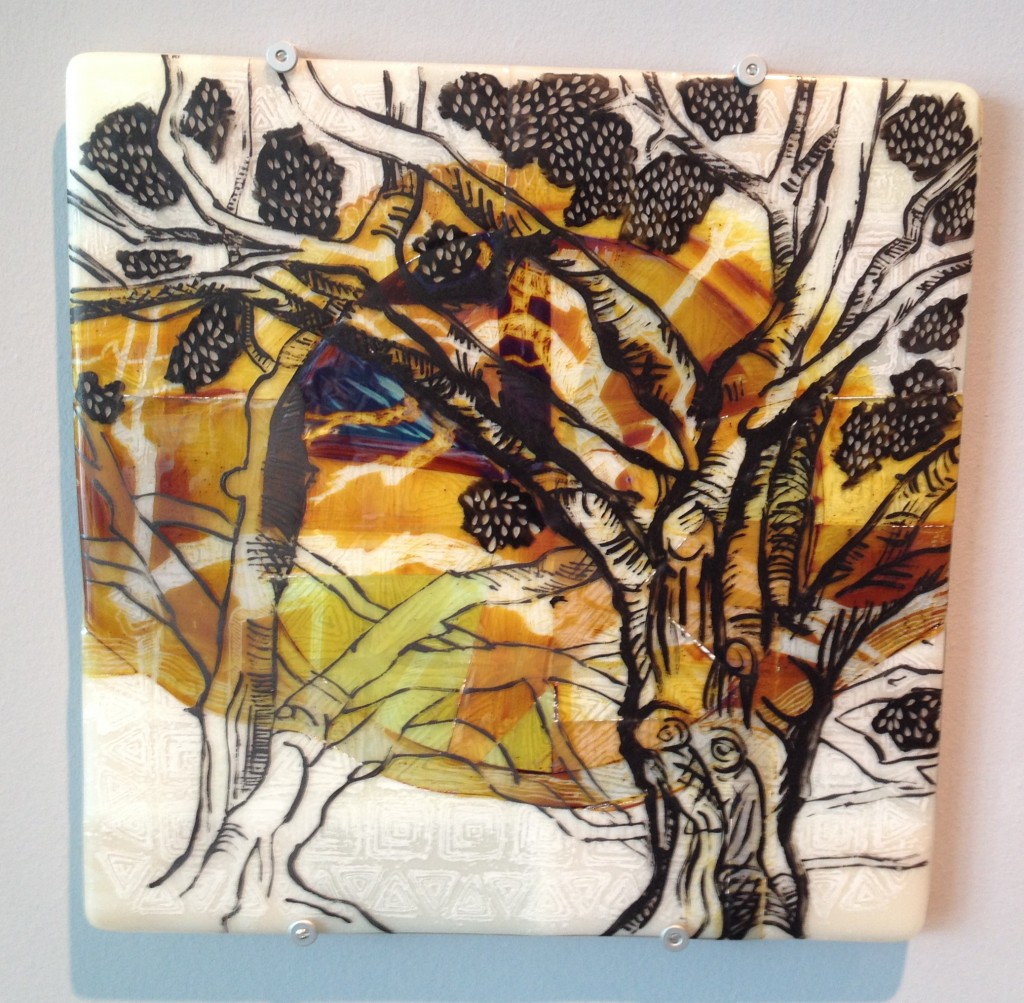
OAK TREE, “Alabama Suite,” 2013, fused, painted and printed enamel, silver stain, sandblasted. 22″ H.
ALABAMA SUITE
The Alabama Suit was begun a year after I returned from my Fulbright Fellowship experience in Korea in 2012. While there, I observed how the land influences the culture. The location of the capital city, where it is situated to both the mountains and the Han River was important as relating to geomancy and the selection of a fortuitous site. While approaching the city of Mobile situated on the bay, on my initial flight, the serpentine patterns of the earth and rivers of the delta were presented from the air as two rivers become five. South Alabama is a wondrous place inhabited by living sculptures; the gestural oaks, along with a vast number of species exemplifying the fecundity of the subtropical place. Traveling across the world and then returning to what I now call home has opened my eyes to what is unique about this area; both natural and man made.
I created a series of drawings in fusible compatible glass; using both a brush and sgraffito line made with a stick. My line is of silver stain and black vitreous enamel; both traditional ways of painting glass that originated in medieval Europe. The Korean work I admired most was also made in the 14th century. The panel work is layered and fired in a nontraditional way. Imagery is both additive and subtractive and may involve sandblasting of the glass. To evoke atmosphere, I have printed a layer of vitreous enamel pattern. Each panel is fired multiple times.
Sculpture
GRAIL VARIATIONS
The Grail Variation series includes the Suit of Wands of the Tarot is explored through color and pattern in glass. Theses are the cards that represent creativity. The stacked sculpture, first blown and then kiln transformed through casting, references the fecundity of flora as an analogy for creativity.
Previous work in the series was focused on the Suit of Cups, which describe goodness.
8 of Cups – Notre Same de Sous-Terre is blown glass is assembled and then invested in a mold. The work is re-melted as it is fused, distorting and reinventing itself through a trial by fire. This transformative process is an analogy for the passage time and the transience of beauty, evidence of both the physical world and the imagination.
In the Tarot, the Eight of Cups represents the making of choices—rejecting the obvious and the easy—and honors the feminine maverick, the Black Madonna: Notre Dame de Sous-Terre of the underworld. She is Mother Earth and represents the long and winding journey of the artist-as is above is below.
The sculptures are not illustrations of the cards, they are instead, dimensional impressions suggested by each card, and very formalist in terms of color and how the individual objects are stacked in the composition.
Commissions
The artist’s work has been commissioned by various businesses and organizations for installation in public spaces and also by private collectors for their personal residence. These opportunities offer a welcome challenge in balancing the needs of the space, the desires of the client and the integrity of the art. Some of this work can be seen at:
Publications
BOOKS:
 Glass Art from the Kiln
Glass Art from the Kiln
- Hardcover: 272 pages
- Publisher: Schiffer Publishing, Ltd. (October 28, 2010)
- Language: English
- ISBN-10: 0764335421
- ISBN-13: 978-0764335426

